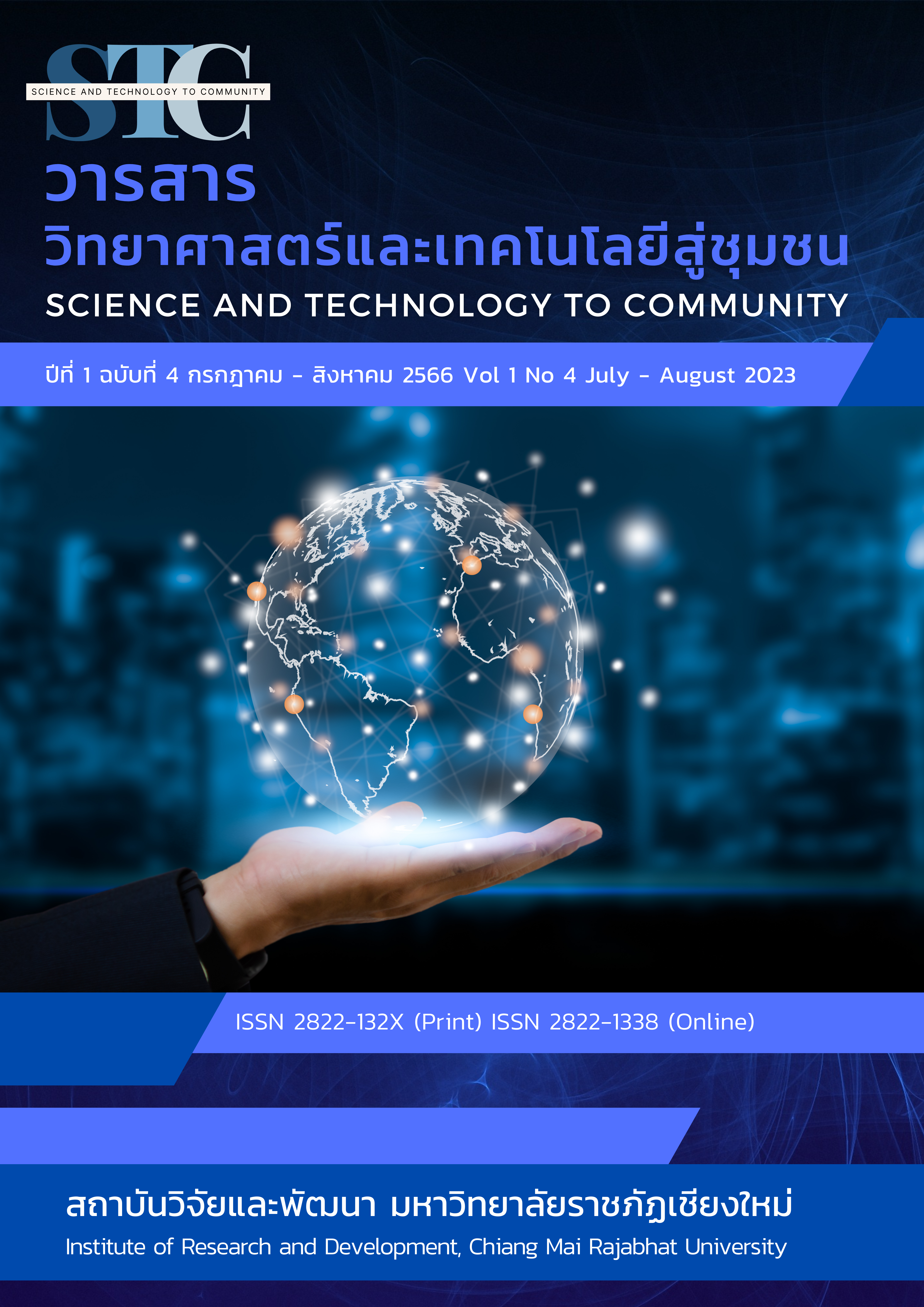เทคนิคการเตรียมพริกชี้ฟ้าแดงอบแห้งให้ได้มาตรฐานสินค้าเกษตรและอาหารชุมชน
DOI:
https://doi.org/10.57260/stc.2023.543คำสำคัญ:
การลวก, การแช่โพแทสเซียมเมตาไบซัลไฟต์, การอบแห้ง, พริกชี้ฟ้าแดง, เทคนิคการเตรียมบทคัดย่อ
งานวิจัยนี้มีวัตถุประสงค์เพื่อศึกษาเทคนิคการเตรียมพริกชี้ฟ้าแดงโดยเปรียบเทียบอุณหภูมิการลวก (60 80 และ 95 องศาเซลเซียส ลวกนาน 3 นาที) และระดับความเข้มข้นของสารละลายโพแทสเซียมเมตาไบซัลไฟด์ (ร้อยละ 0.05 0.10 และ 0.15 มวลต่อปริมาตร แช่นาน 3 นาที) เปรียบเทียบกับพริกไม่ได้ผ่านการลวกหรือแช่สารละลายโพแทสเซียมเมตาไบซัลไฟด์ (ควบคุม) ก่อนนำพริกชี้ฟ้าแดงไปอบแห้งที่อุณหภูมิ 60 องศาเซลเซียส นาน 30 ชั่วโมง วิเคราะห์คุณภาพด้านความชื้น ค่าวอเตอร์แอคทีวิตี ค่าสี ปริมาณแคปไซซิน อะฟลาทอกซินและปริมาณจุลินทรีย์ทั้งหมดและรา โดยการลวกที่อุณหภูมิสูงกว่า 60 องศาเซลเซียสมีผลต่อการลดความชื้น ค่าวอเตอร์แอคทีวิตี การสูญเสียปริมาณแคปไซซิน นอกจากนี้การลวกทำให้ผลิตภัณฑ์พริกแห้งมีสีแดงลดลงและเกิดสีน้ำตาลคล้ำ (p0.05) ส่วนการแช่สารละลายโพแทสเซียมเมตาไบซัลไฟด์ช่วยรักษาคุณภาพทางด้านสี ปริมาณแคปไซซิน ได้มากกว่าการลวก (p
0.05) การเตรียมตัวอย่างทั้ง 2 วิธีสามารถลดปริมาณจุลินทรีย์ทั้งหมดและราได้คุณภาพผลิตภัณฑ์สุดท้ายได้มาตรฐานผลิตภัณฑ์อาหารชุมชนไทย กรรมวิธีเตรียมตัวอย่างที่เหมาะสมที่ผู้ประกอบการและวิสาหกิจชุมชนนำไปปฏิบัติได้ คือ การแช่พริกชี้ฟ้าแดงในสารละลายโพแทสเซียมเมตาไบซัลไฟด์ ความเข้มข้นร้อยละ 0.15 นาน 3 นาที ก่อนอบแห้ง
Downloads
เอกสารอ้างอิง
นักสิทธิ์ ปัญโญใหญ่. (2553). กฎหมายและมาตรฐานอาหาร. เชียงใหม่, มหาวิทยาลัยราชภัฏเชียงใหม่.
พชร ว่องไพศาลกิจ, กระวี ตรีอำนรรค และ เทวรัตน์ ตรีอำนรรค. (2562). การอบแห้งพริกด้วยเครื่องอบแห้งอุณหภูมิต่ำที่เสริมการทำงานด้วยเครื่องสุญญากาศเทอร์โมอิเล็กทริค. วารสารวิชาการและวิจัย มทร. พระนครสาขาวิทยาศาสตร์และเทคโนโลยี, 14(1), 82-96. https://ph02.tci-thaijo.org/index.php/RMUTP/article/view/237676
สำนักงานมาตรฐานผลิตภัณฑ์ชุมชน. (2547). มาตรฐานผลิตภัณฑ์ชุมชนพริกป่น มผช.492/2547 กรุงเทพมหานคร, กระทรวงอุตสาหกรรม.
สำนักงานมาตรฐานสินค้าเกษตรและอาหารแห่งชาติ. (2553). มาตรฐานสินค้าเกษตร มกอช. 3001-2553 พริกแห้ง. กรุงเทพมหานคร, กระทรวงเกษตรและสหกรณ์.
Ahmed, J., Shivhare, U. S., & Raghavan, G. S. V. (2000). Effect of pretreatment on drying characteristics and color of dehydrated green chilli. Journal of Food Science & Technology, 38(5), 504-506.
AOAC. (1995). Official Methods of Analysis of AOAC International. 15th ed. Virginia, USA: AOAC International.
AOAC. (2000). Official Methods of Analysis of AOAC International. 17th ed. Washington, USA: AOAC International.
Artnaseaw, A., Theerakulpisut, S., & Benjapiyaporn, C. (2010). Development of a vacuum heat pump dryer for drying chilli. Biosystems Engineering, 105(1), 130-138. https://doi.org/10.1016/j.biosystemseng.2009.10.003
Chaethong, K., Tunnarut, D. and Pongsawatmanit, R. (2012). Quality and Color Parameters of Dried Chili and Chili Powder Pretreated by Metabisulfite Soaking with Different Times and Concentrations. Kasetsart Journal (natural Science), 46, 471-484. https://li01.tci-thaijo.org/index.php/anres/article/view/242901
Davis, C. B., Markey, C. E., Busch, M. A., & Bush, K. W. (2007). Determination of capsaicinoid in Habanero peppers by chemometric analysis of UV spectral data. Journal of Agriculture and Food Chemistry, 25(55), 5925-5932. https://doi.org/10.1021/jf070413k
Di Scala, K., & Crapiste, G. (2008). Drying kinetics and quality changes during drying of red pepper. LWT-Food Science and Technology, 41(5), 789-795. https://doi.org/10.1016/j.lwt.2007.06.007
Doymaz, I. and Pala, M. (2002). Hot-air drying characteristics of red pepper. Journal of Food Engineering, 55(4), 331-335. https://doi.org/10.1016/S0260-8774(02)00110-3
Eissa, H. A., Mostafa, B. E. and Hussein, A. S. (2007). Capsaicin content and quality characteristics in different local pepper varieties (Capsicum annum) and acid-brine pasteurized puree. Journal of Food Technology, 5(3), 246-255. https://medwelljournals.com/abstract/?doi=jftech.2007.246.255
Geetha, R., & Selvarani, K. (2017). A study of chilli production and export from India. International Journal of Advance Research and Innovative Ideas in Education, 3(2), 205-210.
Gupta, P., Ahmed, J., Shivhare, U. S., & Raghavan, G. S. V. (2002). Drying characteristics of red chilli. Drying Technology, 20(10), 1975-1987. https://doi.org/10.1081/DRT-120015579
Harrison, M. K. and Harris, N. D. (2006). Effects of processing treatments on recovery of capsaicin in jalapeno peppers. Journal of Food Science, 50(6), 1764-1765. https://doi.org/10.1111/j.1365-2621.1985.tb10590.x
Hashmi, M. S., Alam, S. Riaz, A., & Shah, A. S. (2007). Studies on microbial and sensory quality of mango pulp storage with chemical preservatives. Pakistan Journal of Nutrition, 6(1), 85-88. https://scialert.net/abstract/?doi=pjn.2007.85.88
Hossain, M. A., & Bala, B. K. (2002). Thin-layer drying characteristics for green chilli. Drying Technology, 20(2), 489-505. https://doi.org/10.1081/DRT-120002553
Hossain, M. A., & Bala, B. K. (2007). Drying of hot chilli using solar tunnel drier. Solar Energy. 81(1), 85-92. https://doi.org/10.1016/j.biosystemseng.2005.05.015
Kaleemullah, S. and Kailappan, R. (2005). Drying kinetics of red chillis in a rotary dryer. Biosystems Engineering, 91(1), 15-23.
Kieu, V. T. D., Nguyen, P. B., Đai, T. T., & Luan, N. T. (2021). The effect of blanching and drying process to the quality of Capsicum Frutescens L. American. Journal of Engineering Research, 10(1), 192-196. http://insightsociety.org/ojaseit/index.php/ijaseit/article/view/12132/pdf_1786
Klieber, A. (2000). Chilli spices production in Australia. A report for the rural industries research and development corporation. publication No. 00/33, Project No. UA-38A. Rural Industries Research and Development Corporation. Australia.
Marwatia, T., Wanitaa , Y. P., Djaafara, T. F., Hatmia, R. U., Apriyatia, E., & Indrasaria, S. D. (2021). Effect of blanching and drying process on physicochemical and microbiological characteristics of dried chili. International Journal on Advanced Science Engineering Information Technology, 11(3), 1001-1006. http://insightsociety.org/ojaseit/index.php/ijaseit/article/view/12132/pdf_1786
Moon, K. M., Kwon, E., Lee, L., and Kim, C. Y. (2020). Recent trends in controlling the enzymatic browning of fruit and vegetable products. Molecules, 25(12), 2754. https://doi.org/10.3390/molecules25122754
Orak, H. H., & Demirci, M. (2005). Effect of different blanching methods and period of frozen storage on enzyme activities and some quality criteria of hot and sweet red peppers (Capsicum annuum L.). Pakistan Journal of Biological Sciences, 8(4), 641-648. DOI:10.3923/pjbs.2005.641.648
Schweiggert, U. Schieber, A., & Carie, R. (2006). Effects of blanching and storage on capscicinoid stability and peroxidase activity of hot chilli peppers (Capsicum frutescens L.) Innovative Food Science & Emerging Technologies, 7(3), 217-224. DOI:10.1016/j.ifset.2006.03.003
Scoville, S. (2019. Scoville unit. Available from https://scovillescale.org/chili-pepper-scoville-scale/
Skerget, M. and Knez, Z. (1997). Solubility of binary solid mixture β-carotene-Capsaiin in dense CO2. Journal of Agriculture and Food Chemistry, 45, 2066-2069. DOI: 10.1021/jf960936k
Taranto, F., Pasqualone, A., Mangini, G., Tripodi, P., Miazzi, M. M., Pavan, S., & Montemurro, C. (2017). Polyphenol Oxidases in Crops: Biochemical, Physiological and Genetic Aspects. International Journal of Molecular Sciences, 18, 377; DOI:10.3390/ijms18020377
Tasirin, S. M., Kamarudi, S. K., Jaafar, K., & Lee, K. F. (2007). The drying kinetics of bird’s chillies in a fluidized bed dryer. Journal of Food Engineering, 79(2), 695-705. https://doi.org/10.1016/j.jfoodeng.2006.02.032
Tontard, S., & Therdthai, N. (2009). Preliminary study of chilli drying using microwave assisted vacuum drying technology. Asian Journal of Food and Agro0Industry, 2(2), 80-86.
Tunde-Akintunde, T. Y., & Afolabi, T. J. (2009). Drying of chili pepper (Capsicum frutscens). Journal of Food Process Engineering, 33(4), 649-660. DOI:10.1111/j.1745-4530.2008.00294.x
Vaga-Galvez, A., Lemus-Mondaca, R., Bilbao-Sainz, C., Fito, P., & Andres, A. (2008). Effect of air-drying temperature on the quality of rehydrated dried red bell pepper (var. Lamuyo) Journal of Food Engineering, 85(1), 42-50. https://doi.org/10.1016/j.jfoodeng.2007.06.032
Wangcharoen, W., & Morasuk, W., (2007). Antioxidant capacity and phenolic content of chillies. Agriculture and Natural Resources, 41(3), 561-569. https://li01.tci-thaijo.org/index.php/anres/article/view/244281
Wiriya, P., Paiboon, T., & Somchart, S., (2009). Effect of drying temperatures and chemical pretreatments on quality of dried chilli. International Food research Journal, 16(3), 441-454.
ดาวน์โหลด
เผยแพร่แล้ว
รูปแบบการอ้างอิง
ฉบับ
ประเภทบทความ
สัญญาอนุญาต
ลิขสิทธิ์ (c) 2023 วิทยาศาสตร์และเทคโนโลยีสู่ชุมชน

อนุญาตภายใต้เงื่อนไข Creative Commons Attribution-NonCommercial-NoDerivatives 4.0 International License.
1. บทความ ข้อมูล เนื้อหา รูปภาพฯลฯ ที่ได้รับการตีพิมพ์ใน “วารสารวิทยาศาสตร์และเทคโนโลยีสู่ชุมชน” ถือเป็นลิขสิทธิ์ของวารสารวิทยาศาสตร์และเทคโนโลยีสู่ชุมชน มหาวิทยาลัยราชภัฏเชียงใหม่ หากบุคคลหรือหน่วยงานใดต้องการนำทั้งหมดหรือส่วนหนึ่งส่วนใดไปเผยแพร่ต่อหรือกระทำการใดๆ จะต้องได้รับอนุญาตเป็นลายลักษณ์อักษรจาก วารสารวิทยาศาสตร์และเทคโนโลยีสู่ชุมชน มหาวิทยาลัยราชภัฏเชียงใหม่
2. เนื้อหาบทความที่ปรากฏในวารสารเป็นความรับผิดชอบของผู้เขียนบทความโดยตรง ซึ่งกองบรรณาธิการวารสารไม่จำเป็นต้องเห็นด้วยหรือร่วมรับผิดชอบใดๆ














